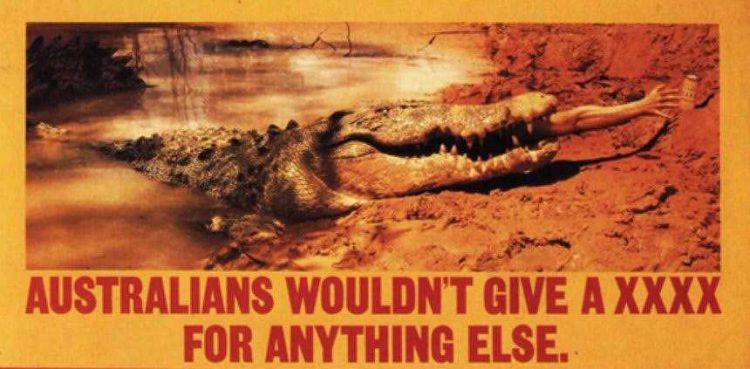In this guest post, Edge’s executive creative director Matt Batten (pictured below) takes on the rather fruity topic of how to swear in ads. And, yes, the article contains its fair share of swearing! You have been warned…
“Daddy, when are you going to teach me how to cut with a sharp knife and use naughty words?” asked my five-year-old as I drove her to daycare.
I figure she’ll be dropping f-bombs long before our client brands will.
But why? After all, they’re just words. And yet, they’re not ‘just’ words.
There are currently 171,476 words in the English language. Of those, the Collins English Dictionary determined there are just 16 truly naughty words, after downgrading 54 others from “taboo” to “slang” or merely “informal”, including bollocks and gangbang.
Over the centuries, taboo words have changed. A medieval nun wouldn’t have batted an eyelid over ‘shit’ or ‘piss’ as those words were commonplace 500 years ago. And the c-bomb was famously and publicly included in street names all over England between 1230 and 1561AD. In many European languages, the word for “bear” was taboo simply because it was a big scary animal that ate people. Back then, “by God’s nails” was the most shocking expletive and would have seen the utterer completely “sarded” or “swived” – both ancient words that mean the same as today’s “fucked.”
In 2015, three Australian protestors had charges of ‘offensive language’ dropped after they’d been arrested for shouting “Fuck Fred Nile” over a megaphone in public. The judge ruled “fuck” to be a part of everyday Aussie vernacular, citing the inoffensive usage in “you fucking beauty!”
Thus is the constant evolution of language.
However, swearing is still blacklisted from advertising. The Advertising Standards Board’s (ASB) code of ethics includes Section 2.5 Language, which provides guidelines on obscene terms and obscured obscenities. The Board, now known as Ad Standards, conducts rulings on consumer complaints. The ASB website puts all the cases into public domain – some very interesting reading – to show how they determine if an ad gets banned. Or not.
Over the years, advertisers and agencies have had a fucking good crack at getting swear words into ads. It’s a gamble to outright drop a swear into a commercial, even if you think society has evolved so the offending word is no longer offensive. After creating this controversial but charmingly on-brief ad in 2003, Volkswagen had a change of heart and ran it online rather than on-air, citing “budget cuts”.
If writing a swear word into a script isn’t possible, here are a few ways potty-mouthed creatives have tried to give their client’s ads that special oomph that only a swear word can muster.
METHOD 1: THE FORKING SWITCH
One of the primary methods is to replace the swear word with an innocuous word that sounds similar. Most famous was Kmart’s “Ship My Pants” in the US, which didn’t air on TV but was used as online content.
Back in 1999, a very young Rich Hall faux-swore in a hilarious but odd commercial for Miller beer.
Homegrown examples of faux profanity include YouFoodz’s 2017 TVC ‘Un-forking-believable’ that featured a kid doing a Gordon Ramsey impersonation with a fork.
The ASB banned the YouFoodz ad. However, according to case report 0423/17, the Board considered the ad made it obvious the kid wasn’t actually swearing but found the ad to be in breach because it was a child pretending to swear. The ad was banned but reappeared with beeps over the non-swearing. Unfortunately, it still drew complaints and the ASB determined it was still in breach, possibly more so, because now the kid appeared to be genuinely swearing instead of pretending.
By comparison, Handee Ultra got away with it when their ad drew consumer complaints but case report 0291/15 found uttering the word “sheeeeet” when you spill something and grab a sheet of Handee Ultra to wipe it up was OK because “the word is contextualised immediately by onscreen imagery of the product being used”.
While KFC recently created a TVC in which a kid replaces “Fuck it!” with “Bucket!”, they weren’t the first. Ten years ago Air Asia ran a billboard using a similar faux-swear that received a complaint but was approved to stay.
METHOD 2: BRAND BOLLOCKS
The second method for sneaking in a swear word is to use the brand name itself. This doesn’t work for all brands, but has proven to be effective at dodging ASB bullets.
Decades ago, the sunshine state’s own beer brand XXXX made great use of their apparently censored name to imitate a censored swear word.
A personal favourite is BCF, the boating, camping and fishing retailer who wants us to have BCFing fun. This light-hearted and strategically insightful ad received a few complaints but the ABS dismissed them, determining that while ‘effing’ in isolation would be a breach, the ad by virtue of the jaunty jingle and the graphics clearly explained that F is for fishing. A case of profanity being in the viewer’s ear, rather than the speaker’s mouth.
The brand that took this to a new level was French Connection in 1991 when founder Stephen Marks and ad legend Trevor Beattie saw the opportunity for a massive rebrand on the fax header from FC’s Honk Kong office that read “From FCHK to FCUK”. The controversial but pivotally successful initialism lasted for 14 years worldwide, yet has remained in the consumer vernacular.
METHOD 3: F*** YOURSELF
The third way to include profanity in an ad without actually including it is by self-imposed censorship: replacing the taboo word with another sound like a beep or a safe word. (My safe word is “pie” – because getting someone to stop should be easy as.)
IKEA won a silver Siren award for a radio ad about their kitchen product, which includes 6 beeps over a young boy’s show and tell. Surprisingly, there appears to have been no complaints against this ad so one can assume it flew under the radar in terms of media coverage.
The key to obscuring a word is the context that it’s used. It can’t be used in animosity or nastiness, and should be used in a manner consistent with colloquial use such as venting frustration rather than randomly included for shock or salaciousness.
In the UK, Burger King combined methods two and three to use its brand name as the visible part of the self-censored taboo word.
METHOD 4: FRAK IT
There is a space between what is a taboo word and what sounds like a taboo word. To be truly identified as a swear word, the word must be formally defined (by Oxford, Collins, et al). Otherwise, it’s just a random sound dropped into dialogue at the right contextual moment.
While this method has been employed by TV and film writers to avoid censorship and given us such gems as frak, smeg, frell, zarking fardwarks, yarblockos, jagweed, cloff-pronker and Ross Geller’s double fist bump, it has rarely been used in advertising. The trick is creating a word that sounds like an expletive but isn’t, and using it without aggressive context that could deem your ad a zarking breach by ASB guidelines.
So, why, with many rules governing taboo words, a segment of indignant and outspoken consumers, and the risk of having an ad banned, do we want to swear in ads?
We do it because these words have an important and distinctive effect. They convey human traits and contextual communicative elements that no other words can. They give impact. They can add authenticity to a moment and improve relevance to certain audiences.
A study from Keele University in Staffordshire proved that swearing alleviates pain. In fact, students were able to keep their hands in ice water for 50 per cent longer when they swore. Cognitive scientist Benjamin K. Bergen discovered that responsive expletives originate in a completely different part of the brain than the rest of our language. Swear words live in the animal part of our brain that developed earlier in our history and was once used for grunting, howling and screaming.
When we swear, we’re using raw emotion.
Research from Stanford, Cambridge, Honk Kong University, and Maastricht University found that those who swear are more likely to be honest and perceived as trustworthy because profanity is less deceptive and unfiltered. Behavioral research at the University of Rochester discovered a strong link between swearing and intelligence. Psychologists at the Massachusetts College of Liberal Arts conducted several experiments that showed people who swear have greater vocabularies. And a study from the University of East Anglia found that swearing promotes better teamwork in an office environment.
In conclusion, if you swear, you’re more emotional, intelligent, trustworthy and better spoken as well being a team player and with a higher pain threshold. Fuck yeah. As a brand, swearing in advertising could show you’re more emotional, authentic, and honest.
And for the record, I promised my daughter she will be allowed to add one swear word to her vocabulary each year from the age of 10, but only if she uses them fucking appropriately.
Notes: I opted to exclude the well-known “C U in the NT” tourism campaign because it wasn’t a client-authorised campaign. I also excluded AAMI’s “Woop Woop (Up Ship Creek)” ad because the US Kmart ad used the ship/shit switch four years earlier and to greater effect. For other potty-mouthed advertising, see Orbit’s “Clean Feeling” ad, Irn-Bru’s “Don’t be a Can’t” campaign, KFC’s “FCK” apology print ad, and Virgin’s “Don’t give a shiatsu” billboard.











